
- June 10 2022
Sustainability in Fashion Retail: How Technology is doing its part
Technology has changed the ways of fashion retail. It’s spent years helping organizations improve productivity, communication, operations, and more—and now, the focus has turned towards improving sustainability.
One industry that can benefit greatly from improved sustainability through technology is the fashion industry. There’s lots of room for improvement—especially considering the fashion industry is responsible for 2.1 billion tonnes of carbon emissions each year!
So, how can technology change the fashion industry when it comes to sustainable fashion?
In this article, we’ll take a look at the importance of sustainability in fashion, and how shopping experiences can be improved with technological advancements. There’s so much technology at our fingertips—let’s find out how the fashion industry can use it to operate more ethically and sustainably.
Why is Sustainability in Fashion Retail Important?
Fashion production makes up 10% of humanity’s carbon emissions according to UNECE. That fact alone should be enough to highlight the importance of making fashion more sustainable.
If you’re still not convinced why sustainability in fashion retail is essential, consider that:
- Synthetic fibers account for 35% of microplastics released into the oceans (Common Objective)
- The U.S. throws away up to 11.3 million tons of textile waste each year—around 2,150 pieces of clothing each second (Bloomberg).
- 85% of all textiles go to the dump each year (UNECE).
- 93 billion cubic meters of water is used by the fashion industry annually (UNCTAD).
These statistics highlight the need to make a change in the fashion industry to protect our planet. However, it doesn’t stop there, consumers are demanding change too:
- 35% of US consumers are willing to pay significantly more for sustainable fashion (Statista).
- 67% of survey participants considered the use of sustainable materials to be an important purchasing factor (McKinsey).
- 88% of consumers want brands to be more eco-friendly (Forbes).
- 86% of American consumers believe sustainability is a good goal (Genomatica).
Sustainability is no longer a nice-to-have, it’s a must-have—and consumers in the fashion industry are keen to make the switch to a trend that’s here to stay.
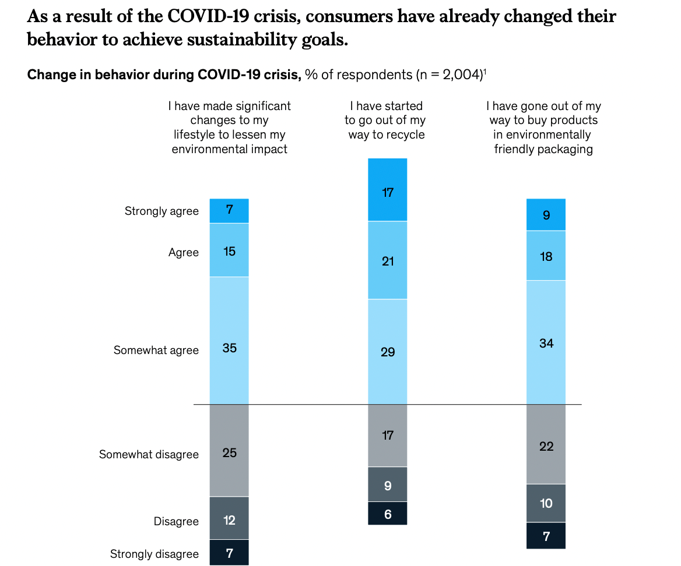
Source: McKinsey Survey – Consumer sentiment on sustainability in fashion
However, with 42% of consumers reporting they’re ‘confused’ about what makes clothing sustainable, the road to an environmentally friendly fashion industry is far from clear. So, let’s take a look at the role technology can play in creating sustainability in fashion.
Improving the Shopping Experience Leads to Reduced Returns
If you’re not already aware of the importance of the shopping experience, then you certainly want to brush up on your knowledge. User experience is more important than ever, particularly when it comes to shopping online and exploring every available product.
Did you know that businesses that deliver better customer experiences will gain revenues between 4-8% above their market competitors?
It pays to be attentive to your consumers and their needs—not only to encourage an initial purchase but to win a return, again and again. As the stats show, part of the consumer experience now includes improving sustainability.
One way organizations can use technology to decrease their carbon footprint is with artificial intelligence. AI has impacted a wide variety of industries—and fashion is no exception. Product discoverability is a key part of the customer experience—you want to ensure customers can find the products they’re looking for, with ease.
AI-powered product catalog enrichment and smart search are two solutions that enable organizations to do just that—find and present the right products to the right customers. This enables organizations to provide search results with 98-99% accuracy—meaning they’re more likely to meet consumers’ needs.
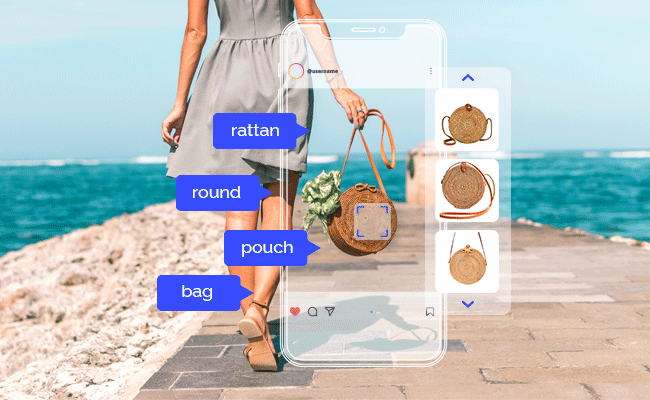
Meeting customers’ needs the first time around makes them less likely to return products they’ve purchased from you. This improves sustainability in fashion, as customers aren’t returning items, and you’re not processing and possibly disposing of perfectly good stock—a win-win.
Another way to help with reducing returned items is by offering virtual try-on. This is a technology that’s rapidly being incorporated into online shopping with the use of VR. Virtual reality can provide online shoppers with an almost real-life experience of shopping in the flesh, from the comfort of their homes.
Increase Personalization with Personal Styling
Data is a powerful thing to have as a business, and can certainly be helpful when understanding the customer’s behavior, wants, and needs. A great way to utilize this data and technology within fashion is with personalization tactics. Personalization is another way of ensuring you meet customer needs from the get-go—limiting the number of returns and potential waste.
Personalizing the experience with the use of smart recommendations can help display products that the data-informed AI algorithm predicts are likely to be highly relevant to the customer. These include:
- Styled shoppable images that enable shoppers to “complete the look” from an initial product search.
- Recommend clothing or accessories that could coordinate with the products shoppers are browsing.
- Similar items to the ones customers are browsing to provide suitable alternatives.
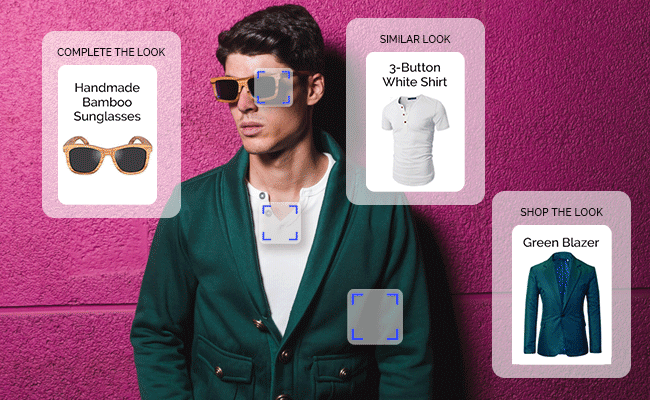
These personalizations can be added across various customer touchpoints including the product display pages, collection pages, and the checkout page itself—and they can have a huge impact.
EyeBuyDirect implemented ViSenze’s product recommendations solutions and saw a 20% increase in click-through rate and a 29x return on investment. This is projected to have contributed to a $1.15 million increase on mobile alone.
Not only is this a win for your business because you’re maximizing your sales, but you’re also benefiting the environment by reducing the carbon emissions made through returns. You’re more likely to gain a dedicated customer base through a personalized shopping experience, than leaving customers to venture alone.
Better Predictions and Recommendations Lead to Reducing Unsold Inventory
When brands are unable to sell all of their stock, they’re left with a tricky question to answer—what now? They can’t hold onto the stock as it takes up too much storage space but they’re also unable to sell it due to a lack of demand. Brands have to get rid of unsold inventory in one way or another—and the process is often environmentally unfriendly.
In order to limit this issue, brands can use technology in two ways to better predict demand and to get the right product to the right customers—while it’s still in trend. This limits the chances of unsold inventory and gives brands more control over their stock.
In order to predict demand and manufacture accordingly, fashion companies need information on what to expect from customers. ViSenze’s smart data solution can help companies make more informed decisions by giving insights on product data, user activity data, sales data, and more. This enables them to anticipate demand, track emerging trends, and stay competitive.
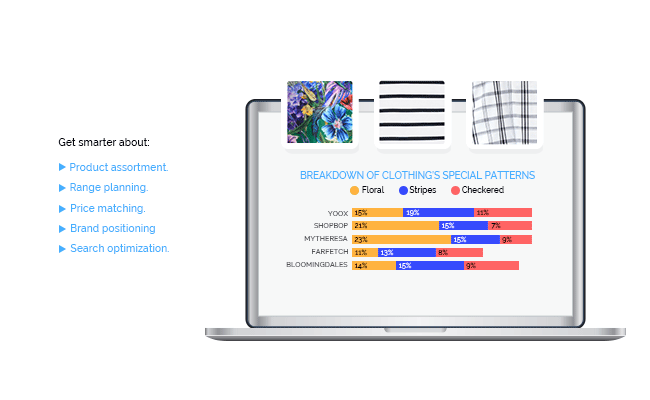
With an idea of what to expect, companies are better positioned to make the right decisions when it comes to placing supplier orders and manufacturing stock. However, that’s not the only way brands can limit unsold inventory. They can also aim to increase sales by giving customers smart recommendations.
Smart recommendations can improve sustainability in fashion by showing customers a wider array of products. This helps reduce an organization’s environmental impact in two ways:
- It helps get more products discovered and purchased, leading to less waste due to unsold inventory.
- It ensures customers buy everything they need in one order, meaning they don’t place multiple orders to be packaged and shipped.
Plus, it’s good for business—ViSenze’s smart recommendations can increase revenue per session by 8%. Smart recommendations can then also be combined with a smart tagging solution to make your products more searchable for your customers. If customers can’t find your products, they can’t buy them—increasing the likelihood you’ll be left with unsold inventory.
Allow for Better Experience with the Circular Economy
Technology can be used effectively when it comes to improving circular economy marketplaces. Creating a circular economy is going to help provide more sustainability in fashion. A circular economy is one that is conscious of waste, making sure to reduce material use, reusing products where possible, and minimizing the waste that’s caused in this industry.
Improving these marketplaces and their websites is a key part of promoting sustainability in fashion. Customers want easy access to products, and there are plenty of solutions available to do this. Circular economy marketplaces can improve the customer experience through catalog enrichment.
Using solutions like Smart Recommendations, Search, and Data, you can understand what your customers want, what they’re looking for, and how they’re looking to engage with brands on a similar sustainable mission to their own.
A circular economy can still be a satisfying experience for customers when using this technology, just take Vestiaire Collective as an example.
Terms that consumers type into the website’s search box can help them easily find the desired pre-owned, luxury products that they’re after. Smart Visual Search helps customers find what they’re looking for without having to trawl through pages of products. This type of technology can pull in a 29x return on its investment.
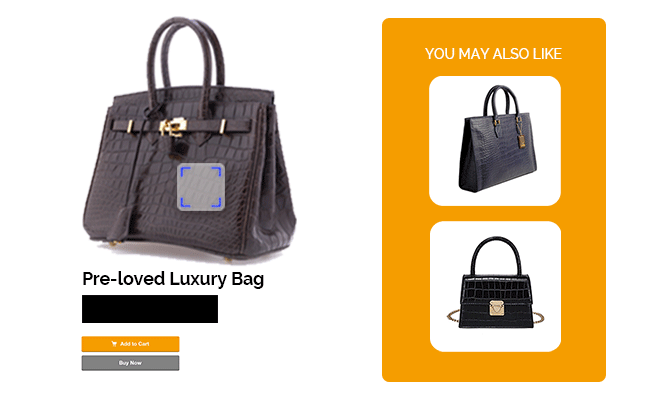
Fashion can certainly be more sustainable, it just requires a little more effort on the business’s part. Fast fashion is likely to always be part of fashion as we know it, but it can become more sustainably conscious with the help of technology and unity among all players in the industry.
Sustainable Fashion Retail is the Future
Sustainable fashion retail is something that’s being encouraged across the entire fashion industry and it’s being enforced through customers. With 67% of consumers considering sustainable materials to be a factor before purchasing a fashion item, it’s in the business’s interest to take sustainability seriously.
ViSenze is a platform that’s highly effective as an AI-powered, smart product discovery tool. Help provide your customers with a personalized and seamless experience while growing your business into a more sustainable organization.
Sign up for a ViSenze demo to see how the platform can help your business in this eco-conscious world, and do right one thread at a time.

